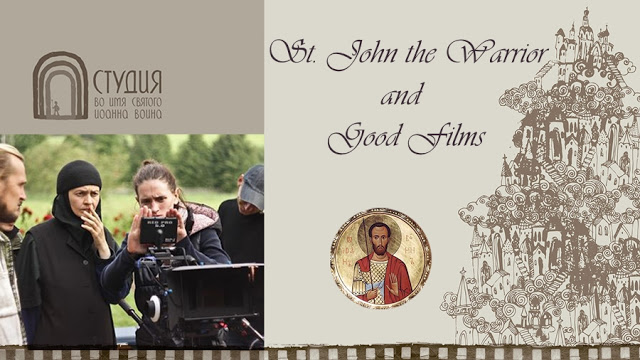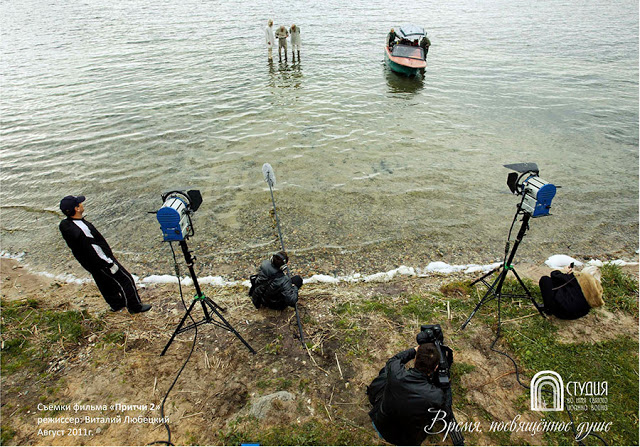
There is little information about Holy Martyr John the Warrior. He was an officer in the army of Emperor Julian the Apostate sent to persecute and kill Christians. Instead, he helped them. He warned them of the danger, released some prisoners of faith from jail or helped them to escape. When the emperor figured it out, he threw St John into prison. Soon, Julian the Apostate was killed in the war with Persians in 363. St John the Warrior was released. He continued doing good until he died at an advanced age.
The audio (later video) studio of our Convent was named in honour of this saint. Today, we’re going to learn about the Studio in honour of St John the Warrior firsthand: Nun Joanna (Orlova) was in charge of the Studio for about 13 years and remembers how it began…
![]()
“We received a number of audio cassettes with recorded talks by Archimandrite Sophrony (Sakharov),” Nun Joanna recalls. “Their sound quality left a lot to be desired, so we came up with the idea to restore the recordings. A good sound engineer, who was inspired by the talks of Elder Sophrony, was found in no time.
However, the talks of our spiritual father, the Rev Andrew Lemeshonok, were the real starting point for our audio studio. People would always come to his talks at Ss Peter and Paul Cathedral with voice recorders, and sometimes those recordings caused problems. Seeing this, Father Andrew blessed me to record his talks. I had to learn to work with sound.
Originally, we thought that our mission was limited to recording Father Andrew’s talks: they are the best part of our experience at the Convent and it would be great if people from other places could listen to them. However, Father Andrew blessed us to record akathists, too. In fact, monastic chants can tell a lot about the Convent. Our first recording of the Monastic Choir happened on the radio. We recorded and edited the recording on tape. Our first recordings were the Akathist to the Inexhaustible Chalice icon of the Mother of God, the Akathist to Holy Martyr Elisabeth, and the Akathist to Saint Nicholas the Wonderworker.
All great endeavours start small. Likewise, the work of the audio studio did not stop at audio recordings. Nun Joanna shot the first film about the Convent, titled The Path of Love. Currently, the Studio has produced about 20 documentaries, fiction films, and cartoons, many of which have won awards at international film festivals, such as Russia, Listapad, Pokrov, Vstrecha, Zolotoy Vityaz, ArtDocFest, Radonezh, Luchezarny Angel, Animayevka, Religion Today, and others.
“Again, it began with the words of the spiritual father of our Convent,” Nun Joanna says. “Father Andrew suggested during a meeting, ‘Why don’t you try making films?’ Our first film was The Path of Love, shot in 2006. It is a short film about the history of our Convent, our Sisterhood, and their social ministry, combined with the biography of the Holy Martyr Grand Princess Elisabeth. It was great but it is out of date already. We will have to produce a new film about the Convent in the future. Right now, God does not bless us to do so. Maybe, we are not ready for the new film yet.”
Why did St John the Warrior become the Studio’s holy patron?
It was definitely God’s will that St John the Warrior became our holy patron. We were going through serious troubles in the months leading up to the creation of our Studio, and we were advised to pray to St John the Warrior. Praise the Lord, the troubles passed. It was precisely at that period when we kept asking St John the Warrior for his intercession, that Father Andrew blessed us to pray to him as our patron saint. We have been reading the Akathist to St John literally from the very beginning of our Studio.
Strangely enough, St John always accompanied us. At first, the audio and the video departments of our studio were in the same place. Dmitry Kuntsevich, who is a fresco painter and the head of our mosaic workshop, painted a fresco of St John in just one night. It was a masterpiece: his inspiration poured out onto the wall and transformed its surface into the saint’s image! Later, when the two departments grew in numbers so much that the initial premises were no longer enough, we moved to a building on the Convent’s grounds. All of a sudden, we found out that another fresco appeared on the wall of that building. This time, it was painted by Nun Martha (Matveyeva) very quickly; and it was equally amazing.

Which projects have been especially dear to you and made you happy?
I recall our first serious audio show: the Life of the Holy Martyr Grand Princess Elisabeth. That project was carried out by great people and amazing professionals. Add to this the fantastic background music… In my opinion, this work of art dedicated to our saint was impeccable.
I can’t but mention our audio projects for children. Our musical fairy tales are just spectacular! Just listen to Good Friends. Our audio fairy tales were created in various styles and they turned out to be beautiful and inspirational. Of course, I would also like to recommend our cartoons: they are so colourful and exciting!
I finally managed to accomplish my long-time aspiration to make a documentary about our Father Andrew. In all honesty, the film was born in pain, both creative and emotional. It took a lot of effort for the film director Halina Adamovich to shoot the film and especially to finish it.
It looks like all genuine masterpieces are born in pain, aren’t they?
I don’t know… There are films that are made easily and quickly, like the fresco painted overnight. Sometimes, people have to suffer repeating things all over again…
The film Two Andrews that you’ve mentioned is famous and popular far beyond the borders of Belarus, as are The Nun and Three Parables. These films have won numerous international awards. Did you expect their success? How can you explain their popularity?
We came to a festival with our Community Candle documentary, and won the Grand-Prix again. A woman from the jury steps forward and announces, “Belarusians got the first prize again…” (laughs). That’s how it happens. I don’t know why.
What are the spiritual lessons that you have learned thanks to your obedience as the head of the Studio, having spent so many years in charge of this studio and having been responsible for so many people and so many projects?
After all those years, I find it easy to talk with truck drivers and the brothers who stay in the rehab of the Convent. Perhaps, everything went well thanks to obedience. God builds everything up, and we are only capable of destroying what He has built. All good comes from him, while all bad comes from us…
How did you manage to get along with so many creative people?
Oh, I didn’t. I made them work, and work, and work… I insisted that they had to work hard until they came up with a great product. The advisory board would meet to watch the film, criticise it and send back to the director to keep working. The director would sigh and continue to work.
So, is hard work the main lesson that you’d like to share?
One has to be enthusiastic and industrious to make a film. With that said, everyone could express themselves and realise their potential at the Studio.
The art of cinema is one of the most sought-after visual arts. Do you think that it is able to influence a person’s decision to turn to God and come to the Church?
God can use any tool. I read The Master and Margarita when I was in eighth grade—and it was the book that led me to God, even though it’s really horrible… It’s a complete mystery when and why God opens one’s heart and the person finds God.




